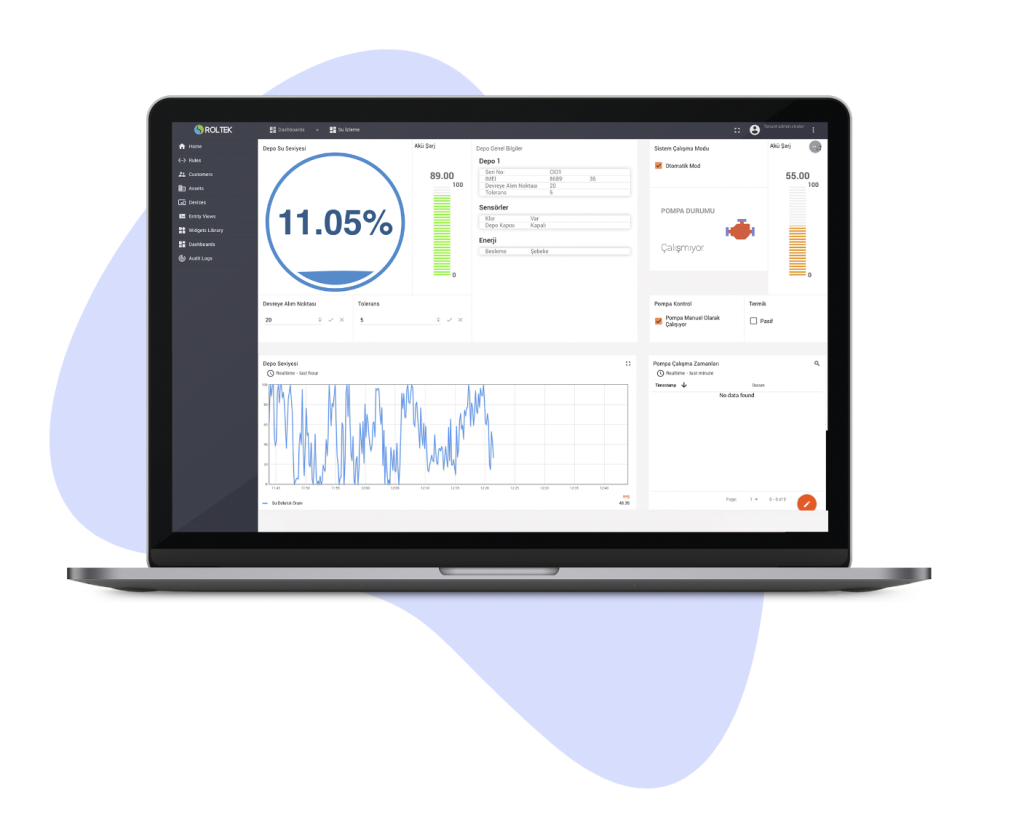Alarm Management on The IoT Platform
In today’s intricate and quickly evolving IoT projects, alarm handling on IoT platforms is essential. This feature provides instant information based on data from various devices, allowing users to understand the status of their systems and intervene quickly when necessary. By providing advantages like energy savings and process optimization. Alarm management on the IoT platform provides a reliable solution in the IoT field, enabling users to easily monitor, manage, and optimize their complex systems.
Alarm management, which supports energy and resource savings, reduces costs by using system resources effectively. It also increases collaboration and enables process optimization through community communication and information. Conditions identified through the alarm identification process are classified at various levels. It is managed according to the degree of urgency. This allows users to identify situations in which they need to intervene as a priority.
FAST IoT Platform
The data collected is typically processed through specialized software, such as a Fast IoT Platform. Highly customizable. Custom workflows, rules, and adapts to your needs. You have the ability to create alerts. Additionally, our platform has a user-friendly and intuitive interface. It provides an intuitive interface that facilitates the management of your IoT devices and data. Plus, you don’t have to be a technical expert to use it.
- Drag&Drop Visualization
- Drag&Drop Rules Engine
- Data collecting
- Low Code Platform
- Alarm Management
- Multi-tenant
IoT Platform Alarm Management; Advantages and Functionalities
- Instant Information and Status Tracking: Alarms provide instant information about devices or processes in the system. For instance, if a sensor surpasses predetermined temperature threshold, you can get an immediate notice.
- Rapid Response and Response: Alarms enable unexpected situations or problems to be detected quickly. In this way, system administrators or users can take the necessary precautions before problems arise.
- Energy and Resource Saving: Alarm management saves energy and resources. Generating alarms under certain conditions ensures effective use of system resources. For example, data transmission begins when a certain state of a device is detected.
- Community Communication and Notification: Alarms notify other users of the system or the community of a certain event, situation. This increases collaboration and sharing.
- Process Optimization: Alarms optimize the performance of processes and devices. If a certain process or device meets a certain condition, an alarm is automatically generated, allowing the necessary corrective actions to be taken.
Alarm Functions
Alarm Identification: The alarm identification process involves determining the conditions that apply to the data at a particular device or data point. These conditions include a specific threshold value, time range, or other data characteristics.
Alarm Levels: Alarms on the Platform are generally classified into three levels; Mild, Moderate and Severe. These categories show the seriousness of a warning, the immediacy of the need for action.
Alarm Triggers: Alarm triggers are rules that ensure that a specific event or situation triggers an alarm. For instance, when temperature sensor readings surpass a predetermined threshold, an alarm trigger is triggered.
Alarm Actions: The actions to be taken in case the alarm is triggered are determined. These actions include options such as sending email or SMS notifications, generating a specific report, or starting a custom action.
Alarm Working Principle
Data Monitoring: Fast IoT Platform continuously retrieves data from devices and data points. This data is tracked and analyzed on the platform.
Condition Check: Specified alarm conditions are constantly checked with incoming data. For example, if the temperature value of a particular sensor exceeds a certain threshold value.
Alarm Trigger: When conditions are met, the alarm is triggered and classified according to the specified alarm level.
Performing Actions: When the alarm is triggered, the specified actions are performed. This includes various actions such as sending notifications to users or initiating a specific action.
Alarm Status Monitoring and Reporting: The platform monitors the status of triggered alarms and presents an alarm status to users through various reports and visualizations.
Alarm History: Records the history of triggered alarms so users can review and analyze past events.
Thanks to these features, alarm management provides a powerful and flexible warning and monitoring system in your IoT projects. This allows you to detect issues with your system and react to specific occurrences fast.
The Importance of Alarm Management in Fast IoT Platform
Alarm management in the Fast IoT Platform allows checking certain conditions based on data from various devices or data points. It also allows sending warnings to the user. Alarms provide instant information and status monitoring. It enables rapid detection of unexpected situations and energy and resource savings. Thanks to these features, system administrators and users get a powerful and flexible warning. Together with key components such as alarm definition, levels, triggers, and actions, the platform offers the possibility to quickly respond to specific events and quickly detect problems in the system.
This alarm management feature on the platform increases reliability and flexibility in IoT projects. It allows users to quickly detect and resolve any problems with their systems. In this way, it copes with the complexity of the IoT ecosystem. Users manage their businesses more efficiently.
Alarms on FAST IoT Platform
All alarms can be accessed via the alarms tab in the side menu.
Detailed information about the alarm can be accessed by clicking on the detail button to the right of the table.
Alarms are also displayed on the dashboard with the alarm table widget.
For IoT projects to be successful, alarm management on the Fast IoT Platform is essential. These features make it possible to quickly detect unexpected situations and save energy. Alarm management also facilitates teamwork and improves community communication, allowing users to solve issues jointly. Alarm handling on the Fast IoT Platform improves business process efficiency, IoT project reliability. In this manner, users may react quickly to particular occurrences, keep enhancing the system’s functionality.
Contact us to learn more about Alarm Management on Fast IoT Platform!
Instagram: roltek2014
LinkedIn: Roltek Technology



